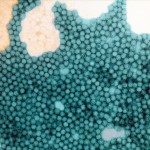Link to Pubmed [PMID] – 9454712
Virology 1998 Feb;241(1):1-13
Poliovirus mutants (PVpi) selected during the persistent infection of human neuroblastoma cells can establish secondary persistent infections in nonneural HEp-2c cells (I. Pelletier, T. Couderc, S. Borzakian, E. Wyckoff, R. Crainic, E. Ehrenfeld, and F. Colbère-Garapin, 1991, Virology, 180, 729-737). Previous results from our laboratory have also shown that, in the genome of PVpi S11 derived from the Sabin 1 strain, the genomic region involved in this phenotype contains 11 missense mutations which map exclusively to the genes encoding the capsid proteins VP1 and VP2. We report here the identification of precise viral determinants able to confer the capacity to establish persistent infections in HEp-2c cell cultures to the lytic Sabin 1 strain. We used a strategy based on the observation that PVpi, after a few months of persistent infection in HEp-2c cells, tend to regain a more lytic phenotype in uninfected HEp-2c cell cultures. We constructed mutant viruses carrying only a few mutations potentially involved in the phenotype of persistence. Two mutations were identified, one corresponding to the substitution His>Tyr of amino acid 142 of VP2 and another corresponding to the substitution Val>Ile of amino acid 160 of VP1. Mutants carrying one or the other of the two determinants established persistent infections in HEp-2c cell cultures in about 20% of the infections. Higher frequencies were obtained with the mutant carrying both determinants (30%), and with PVpi S11 (63%), indicating that the effects of several determinants can be cumulative. The two determinants are localized on the capsid surface in a region known to be involved in the interactions between poliovirus and its cell receptor and in fact, we demonstrate here that in the case of the two persistent mutants, these interactions are modified.
